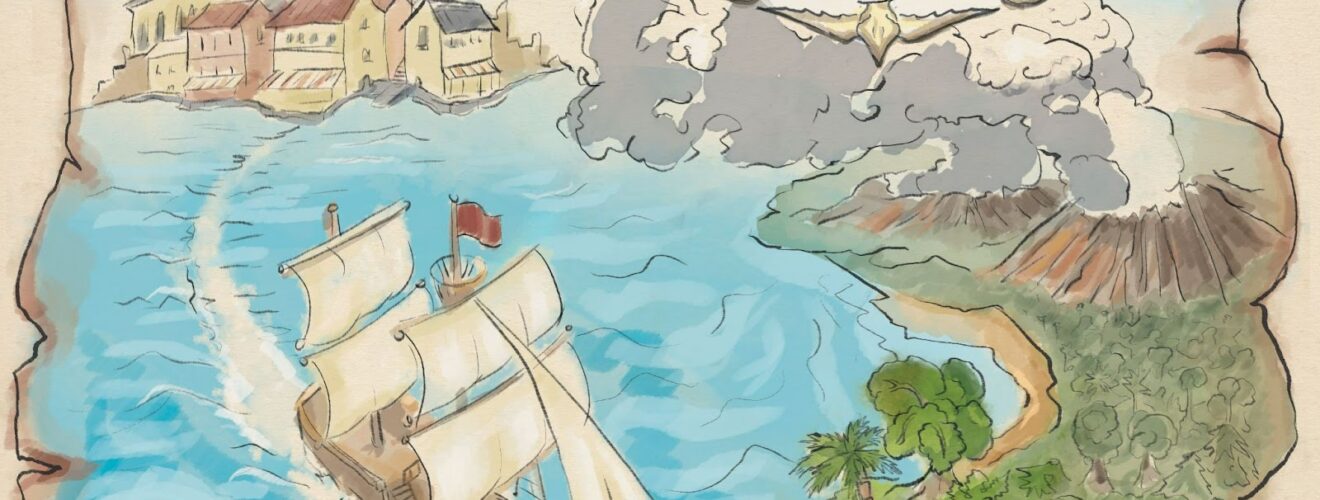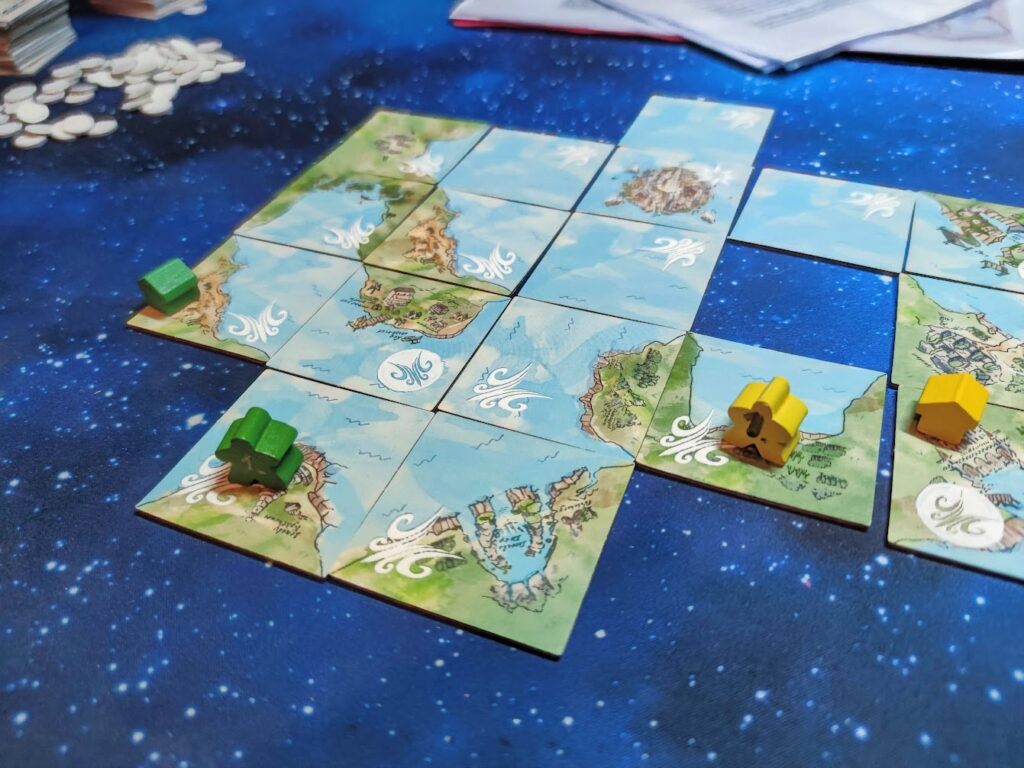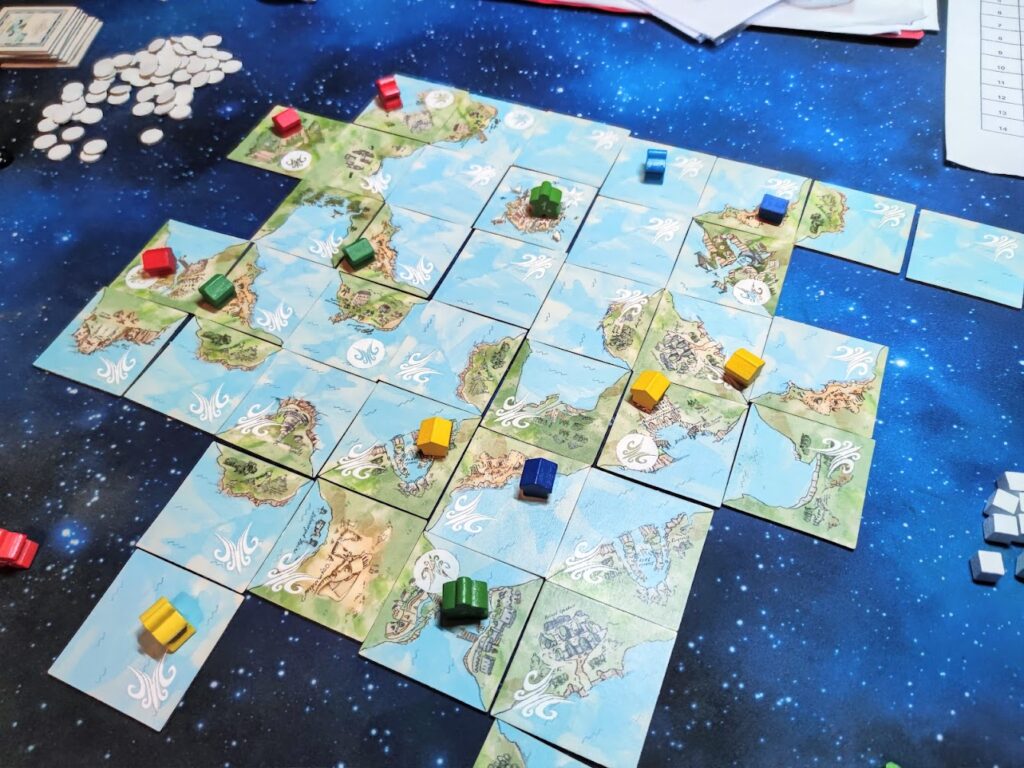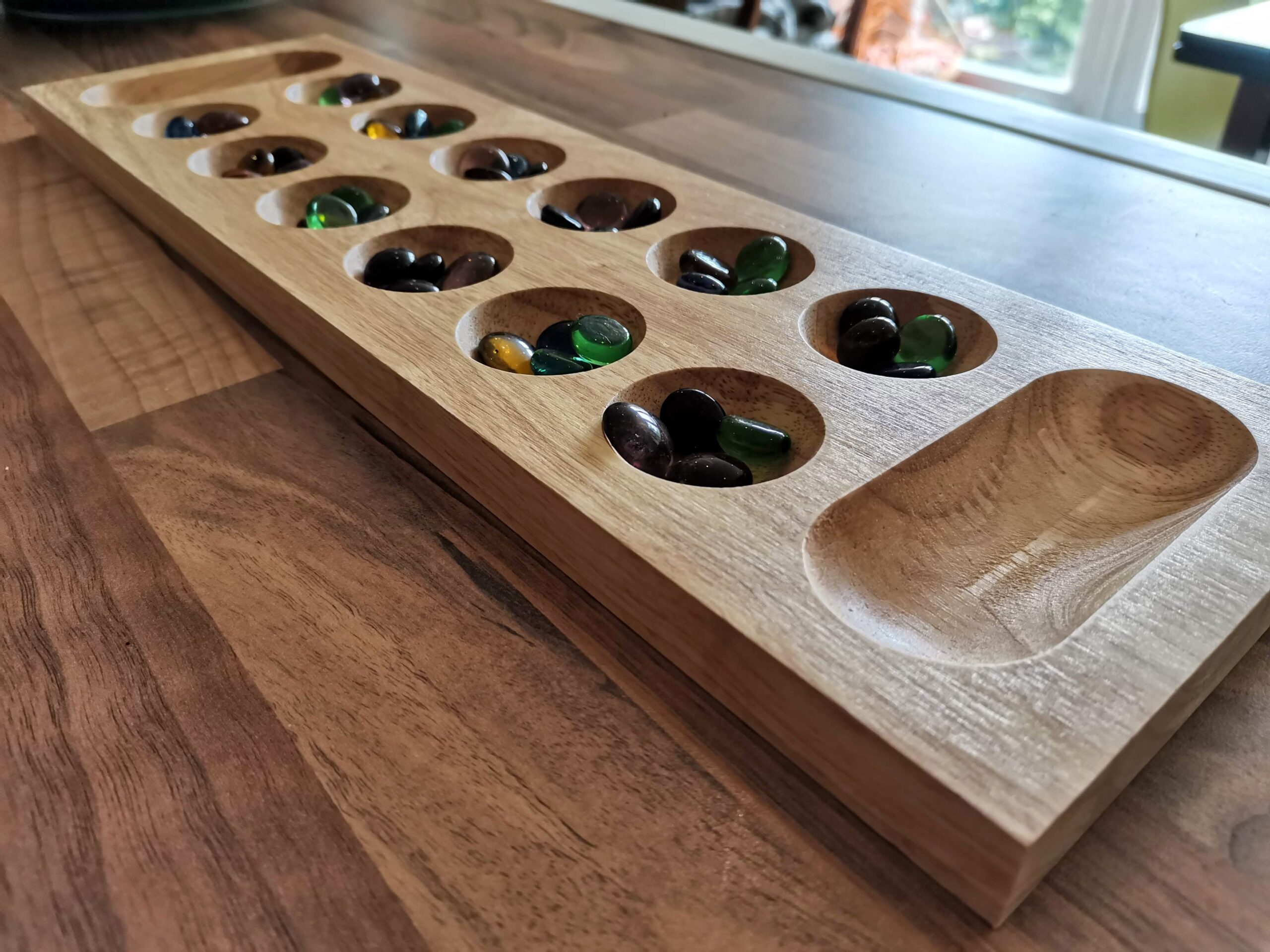Cartolan – Trade Winds Preview

Disclaimer: This preview is based on a prototype of the game. All components, artwork, and rules do not necessarily reflect the final product.
At first glance you’d be forgiven for thinking that Cartolan – Trade Winds is another tile-laying game, aping others like Isle of Skye or the granddaddy, Carcassonne. While it’s true that you draw tiles and place them, matching edges, it’s there that the similarities end. Cartolan has ideas of its own, and if this preview copy is anything to go by, fans of tile games have something new to tempt them.
Throw caution to the wind
Cartolan puts you in the roles of adventurers, seeking to explore the unknown world and open lucrative trade routes with the various ports and cities obscured by the fog of ignorance. Much of this world is water, naked to the wind, and these trade winds play an important part in the game. As you turn over tiles and expand the map, you’ll notice that each of the tiles has an arrow in the corner, showing which way the wind blows.
The wind is employed as a unique mechanism. After your standard turn of moving one of your adventurers twice, you can hop into your hypothetical boat and drift with the wind for another two tiles, as long as it’s over the watery edges of the tiles. Another mechanism lets you add an inn to a tile for a paltry single piece of treasure. When you visit an inn for the first time on your turn it lets you rest and take a full turn of movement again.

I try not to delve into the inner workings of a game, but in Cartolan’s case I wanted to point out this exploration, because it really sets it apart from other tile-layers, like the ones I mentioned above. The world doesn’t get revealed one tile at a time. In a four-player game of Cartolan you can easily expand the initial map of five tiles to more than 20 after just one turn each. You also start to notice that due to the rules about the direction of the wind on newly-added tiles, trade winds start to create large clockwise or anti-clockwise loops, which is nicely thematic.
Fill the coffers
Winning a game of Cartolan means collecting lots and lots of silk – the game’s currency – and there’s loads of it thrown at you. Exploring the world and filling-in gaps is encouraged, because any time a tile gets added, you pocket three silk for each existing edge you touch with it. Bam, that’s nine silk right there. You get more for discovering ports, piracy (see below), and finding the mythical city that’s rumoured* to be in the stacks of tiles.
(*spoiler alert: it’s definitely in there, I’ve seen it).

Cartolan is a very competitive game, and while it doesn’t outright demand that you resort to piracy, it’s definitely encouraged. Landing in the same space as another adventurer lets you turn the way of the Jolly Roger and attack them, potentially stealing all the silk they were carrying. I say potentially because success is based on a game of rock-paper-scissors between the attacker and defender. I really like that the competition is based above the table, but personally, I prefer a decider that can’t be tied. We found it slightly more thematic to get the defender to put a silk token in one hand and see if the attacker can guess which. Winner gets the reward. This is still a preview though, so take that with a pinch of salt.
Piracy is a double-edged cutlass. Pirates cannot place inns or trade, so they need to get back to a city and bank their ill-gotten gains before someone else lands on the same tile as them, and claims a silken reward for arresting them. It’s a refreshing change to see a game in this style have this much interaction. You’re not forced to attack one another if it’s not your bag, but personally, I really enjoy balancing the risk and reward of exploration and getting back to the bank.
Not all plain sailing
Despite wearing the silken finery of a simple tile game, Cartolan as it stands is quite fussy. You’ll find yourself constantly taking and making change with the silk tokens. It’s entirely possible to place four tiles on a turn, and when you consider that you can be claiming silk every time you place a tile, there’s a lot of picking up tokens. The tokens go on your character card before they’re banked, which is the same place as your carried tiles go (you can carry and place some, as well as drawing blind from the stacks), and the text which explains each character’s bonus abilities. The tokens start to fill the cards quickly, and you can’t let it spill over, as each character’s haul is its own. Later in the game you can have up to four adventurers on the go, each with their own tiles, character card, and silk piles, and it can get messy and chaotic.
I hope it doesn’t cause offence for me to guess that the designer, Tom, is a bit of a nerd, like me. Maybe? This is the first preview I’ve been given which comes with a custom online implementation, and a github repo full of the source code (in Python, yummy) for simulating the game. I applaud this approach because it’s clearly been used to balance the game, and it’s a step that’s not usually done to this level by many new designers. My hope is that the same level of care and introspection will get applied to the physical game and the rulebook, both of which could do with some improvement.
Again, take this whole section with the caveat that I’m playing a prototype copy. A very nicely made prototype, but a prototype all the same.
Final thoughts
Cartolan – Trade Winds caught me by surprise. I was expecting another tile-laying game in the same mould as those that came before it, but it’s a fresh, interesting game. It actually plays like a race. The score track is in rows of 15, and if one player manages to get a full row ahead at the front of the pack, they win. You can win by getting to 100 first, or having the most when the tiles run out, but the threat of someone running away and winning early keeps everyone focused on the game state, and you can end up with some unspoken ‘kill the king’ agreements.
There’s a funny kind of duality at the core of Cartolan which I enjoy. The frenetic racing to explore the world and earn the big bucks is in stark contrast to the chill aesthetic and the notion of letting the breeze carry your sailboat over the horizon. There’s a feeling of trying to go about your own business, all the while with one eye on the person ahead of you, their chest laden with goodies, and the other eye on the person behind you with a dagger between their teeth.
It’s a natural next game for those of you who enjoy Carcassonne and Isle of Skye. I’m not saying there’s a direct connection to the way they play, but their exploration and expansion of the tile map are certainly reminiscent of them. I know Tom is actively taking on board the feedback he’s getting from the community at the moment. Between this and the rigorous playtesting and attention to detail, if they get the price point right, I think Cartolan – Trade Winds can, and should do really well.
Preview copy provided by the publisher. Thoughts and opinions are my own.
If you enjoyed this preview and would like to read more like this, consider supporting the site by joining my monthly membership at Kofi. It starts from £1 per month, offers member benefits, and lets me know you’re enjoying what I’m doing.











